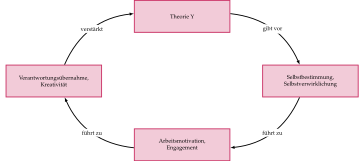XY theory
The theories X and Y are management theories represent or guide philosophies that two completely different images of man. Douglas McGregor first coined Theory X in 1960 during his professorship at MIT in his book The Human Side of Enterprise and saw in it an implicit basis of traditional hierarchical management. However, McGregor rejected Theory X and preferred the alternative of Theory Y that he proposed.
Theory X assumes that humans are naturally lazy and try to avoid work as much as possible. In principle he is motivated from the outside; that means to reward or sanction through extrinsically oriented measures. In contrast, theory Y assumes that people are quite ambitious and willingly imposes strict self-discipline and self-control in order to achieve meaningful goals. He sees work as a source of satisfaction and takes pleasure in his performance. A sense of responsibility and creativity also shape this image of man.
Theories' image of man
Theory X - the person is unwilling
Humans have an innate aversion to work and try to avoid it wherever possible. Due to his reluctance to work, he usually has to be forced, directed, guided and threatened with punishment so that he can make a productive contribution to achieving the organizational goals. He wants to be “taken by the hand” because he has too little ambition, prefers routine tasks and strives for security. He shies away from any responsibility. That is why the manager has to give detailed instructions on every step of the action, energetically instruct and lead and strictly control it. This is the only way to carry out work efficiently. Paying alone cannot make people try hard enough. This means that if the rules are violated, external controls and penalties as well as coercion are required. His behavior is based on the majority opinion.
The assumptions of theory X essentially correspond to the assumptions of Taylorism .
Theory Y - people are committed
Work is very important to people and is an important source of satisfaction because they are by nature willing to perform and motivated from within . The most important work incentives are the satisfaction of the ego needs and the striving for self-realization . Therefore, conditions must be created that motivate people, for example through more self-determination, larger areas of responsibility, more flexible organizational structures, group and project work, etc. If people identify with the goals of the organization, external controls are not necessary. Because he will take responsibility and develop his own initiative . Also creativity is encouraged and challenged. Since this person feels committed to the goals of his company, he will act in favor of the organizational goals. Humans have a high degree of imagination, judgment and ingenuity to solve organizational problems.
The assumptions of theory Y essentially correspond to assumptions of the human relations concept . Theory Y corresponds to most corporate models .
Theory Z - the human is depending
Since theories X and Y can be mutually exclusive, McGregor met his critics in 1964 with the synthesis of the two management theories for theory Z , which was later taken up by William Ouchi and developed independently.
The assumptions of theory Z essentially correspond to the Japanese management style .
The Self-Fulfilling Prophecy of Theories X and Y
The application of theories X and Y can very well be viewed as self-fulfilling prophecies . The application of Theory X requires strict guidelines to be imposed on the employees and to be monitored. In most cases, this leads to passive work behavior, which in turn leads to a low level of responsibility and commitment. The actual work behavior of the employees thus corresponds to the assumptions of theory X. This also applies analogously to theory Y. This situation (or vicious circle ) is shown in the diagrams above.
Characteristics and manifestations
Managers who have a pronounced human image in Theory X have a more authoritarian leadership style , which means that it is strongly goal-oriented, but hardly employee-oriented, because employees are only a means to an end. On the other hand, managers who are more drawn to theory Y have a more cooperative or participative management style and are therefore employee- and goal-oriented.
Theory X is characterized by terms such as superiors, subordinates, commands, instructions and strict control. In contrast, for theory Y there are terms such as employees, target agreements (“ Management by Objectives ”) and delegation of tasks, competence and responsibility.
Structural measures for the manager according to Theory X are control, instructions, reporting obligations of the employees and disciplinary penalties. In theory Y, the focus is on the decentralization of decisions, integration of goals, delegation of responsibility and group decisions ( participation ).
literature
- Helmut Kasper, Wolfgang Mayrhofer (eds.): Personnel management, leadership, organization , 4th edition, Linde, Vienna 2009, ISBN 978-3-7143-0002-4 .
- Georg Schreyögg, Axel v. Werder (Hrsg.): Concise dictionary corporate management and organization , 4th, completely revised edition. Schäffer-Poeschel, Stuttgart 2004, ISBN 978-3-7910-8050-5 .
- Inga Enderle: Images of people in a business context: scope and limits. AVM 2011, Munich, ISBN 978-3-86924-141-8 .
- Schüpbach, H. (2013). Industrial and organizational psychology (UTB basics series). Munich: Ernst Reinhardt.

